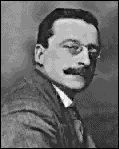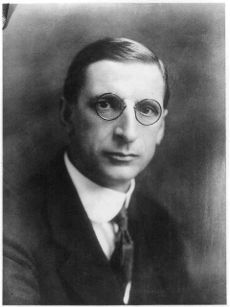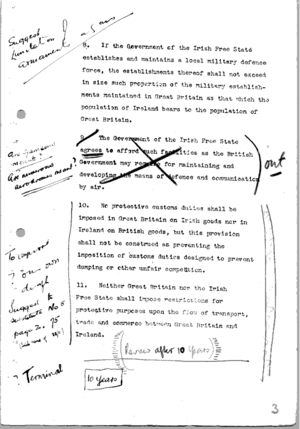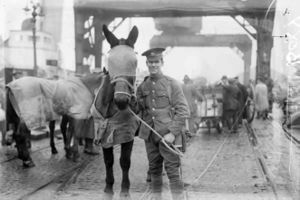المعاهدة الإنگليزية الأيرلندية
| Articles of Agreement for a Treaty Between Great Britain and Ireland | |
|---|---|
 Signature page | |
| التوقيع | 6 December 1921 |
| المكان | 10 Downing Street, London |
| تاريخ السريان | 31 March 1922,[1] fully implemented on 6 December 1922 |
| الحالة | Creation of the Irish Free State, later Ireland |
| الموقعون | قالب:Country data Irish Republic |
| اللغات | English |
| Text of the Treaty | |
The Anglo-Irish Treaty (أيرلندية: An Conradh Angla-Éireannach), commonly known as The Treaty and officially the Articles of Agreement for a Treaty Between Great Britain and Ireland, was an agreement between the government of the United Kingdom of Great Britain and Ireland and representatives of the Irish Republic that concluded the Irish War of Independence.[2] It provided for the establishment of the Irish Free State within a year as a self-governing dominion within the "community of nations known as the British Empire", a status "the same as that of the Dominion of Canada". It also provided Northern Ireland, which had been created by the Government of Ireland Act 1920, an option to opt out of the Irish Free State, which it exercised.
The agreement was signed in London on 6 December 1921, by representatives of the British government (which included Prime Minister David Lloyd George, who was head of the British delegates) and by representatives of the Irish Republic including Michael Collins and Arthur Griffith. The Irish representatives had plenipotentiary status (negotiators empowered to sign a treaty without reference back to their superiors) acting on behalf of the Irish Republic, though the British government declined to recognise that status. As required by its terms, the agreement was ratified by "a meeting" of the members elected to sit in the House of Commons of Southern Ireland and [separately] by the British Parliament. In reality, Dáil Éireann (the legislative assembly for the de facto Irish Republic) first debated then ratified the treaty; members then went ahead with the "meeting". Though the treaty was narrowly ratified, the split led to the Irish Civil War, which was won by the pro-treaty side.
The Irish Free State as contemplated by the treaty came into existence when its constitution became law on 6 December 1922 by a royal proclamation giving the force of law to the Irish Free State Constitution Act 1922.
Content
Among the treaty's main clauses were that:[3]
- Crown forces would withdraw from most of Ireland.
- Ireland was to become a self-governing dominion of the British Empire, a status shared by Australia, Canada, Newfoundland, New Zealand and the Union of South Africa.
- As with the other dominions, the King would be the Head of State of the Irish Free State (Saorstát Éireann) and would be represented by a Governor General (See Representative of the Crown).
- Members of the new free state's parliament would be required to take an Oath of Allegiance to the Irish Free State. A secondary part of the oath was to "be faithful to His Majesty King George V, His heirs and successors by law, in virtue of the common citizenship".
- Northern Ireland (which had been created earlier by the Government of Ireland Act) would have the option of withdrawing from the Irish Free State within one month of the Treaty coming into effect.
- If Northern Ireland chose to withdraw, a Boundary Commission would be constituted to draw the boundary between the Irish Free State and Northern Ireland.
- Britain, for its own security, would continue to control a limited number of ports, known as the Treaty Ports, for the Royal Navy.
- The Irish Free State would assume responsibility for a proportionate part of the United Kingdom's debt, as it stood on the date of signature.
- The treaty would have superior status in Irish law, i.e., in the event of a conflict between it and the new 1922 Constitution of the Irish Free State, the treaty would take precedence.
Negotiators
The negotiators included:


- Providing Secretarial Assistance
| British side |
| Name |
|---|
| Thomas Jones |
| Lionel George Curtis |
| Irish side |
| Name |
| Robert Erskine Childers |
| Fionán Lynch |
| Diarmuid O'Hegarty |
| John Smith Chartres |
Robert Barton was the last surviving signatory. He died on 10 August 1975 at the age of 94.
Notably, the Irish President Éamon de Valera did not attend.
Winston Churchill had a dual role in the British cabinet concerning the treaty: firstly as secretary of state for war hoping to end the Irish War of Independence in 1921; then in 1922, as secretary of state for the colonies (which included dominion affairs), he was charged with implementing it.
Robert Erskine Childers, the author of the Riddle of the Sands and former Clerk of the British House of Commons, served as one of the secretaries of the Irish delegation. Tom Jones was one of Lloyd George's principal assistants, and described the negotiations in his book Whitehall Diary.
Status of the Irish plenipotentiaries

Results
انظر أيضاً
قالب:Campaignbox Irish independence
- Oath of Allegiance (Ireland)
- Anglo-Irish Treaty Dáil vote
- Irish Free State
- Irish Civil War
- Other treaties between Britain and Ireland:
- Anglo-Irish Trade Agreement (1938)
- Sunningdale Agreement (1973)
- Anglo-Irish Agreement (1985)
- Good Friday Agreement (1998)
- St Andrews Agreement (2006)
Notes and references
This article includes a list of references, but its sources remain unclear because it has insufficient inline citations. (December 2015) |
Sources
- Primary
- Text of treaty:
- Final text of the Articles of Agreement for a Treaty between Great Britain and Ireland as signed. from British & Irish Delegations. Documents on Irish Foreign Policy. Vol. Vol.1. p. No.214. Retrieved 21 ديسمبر 2015.
{{cite book}}:|volume=has extra text (help); Invalid|nopp=Y(help); Unknown parameter|nopp=ignored (|no-pp=suggested) (help) - "Treaty between Great Britain and Ireland, signed at London, 6 December 1921" (PDF). League of Nations Treaty Series. 26 (626): 9–19.
- Final text of the Articles of Agreement for a Treaty between Great Britain and Ireland as signed. from British & Irish Delegations. Documents on Irish Foreign Policy. Vol. Vol.1. p. No.214. Retrieved 21 ديسمبر 2015.
- Alternative Proposal from de Valera
- "Proposed Treaty Of Association Between Ireland And The British Commonwealth Presented By President De Valera To The Secret Session Of An Dáil". Dáil Éireann treaty debates. Oireachtas. 1922. p. Appendix 17. Retrieved 21 ديسمبر 2015.
{{cite web}}: Invalid|nopp=Y(help); Unknown parameter|nopp=ignored (|no-pp=suggested) (help)
- "Proposed Treaty Of Association Between Ireland And The British Commonwealth Presented By President De Valera To The Secret Session Of An Dáil". Dáil Éireann treaty debates. Oireachtas. 1922. p. Appendix 17. Retrieved 21 ديسمبر 2015.
- Documents on Irish Foreign Policy: Royal Irish Academy:
- Parliamentary debates:
- Secondary
- Lord Beaverbrook (1963). The Decline and Fall of Lloyd George. London: Collins.
- Winston Churchill, The World Crisis; the Aftermath (Thornton 1929) pp. 277–352.
- Tim Pat Coogan, Michael Collins (1990) (ISBN 0-09-174106-8)
- Tim Pat Coogan, De Valera (1993) (ISBN 0-09-175030-X)
- Knirck, Jason K. (1 يناير 2006). Imagining Ireland's Independence: The Debates Over the Anglo-Irish Treaty of 1921. Rowman & Littlefield. ISBN 9780742541481. Retrieved 21 ديسمبر 2015.
- Frank Pakenham, 7th Earl of Longford, Peace By Ordeal (Cape 1935)
Citations
This article relies on references to primary sources. (December 2015) |
- ^ Irish Free State (Agreement) Act 1922 whose full title is "An Act to give the force of Law to certain Articles of Agreement for a Treaty between Great Britain and Ireland, and to enable effect to be given thereto, and for other purposes incidental thereto or consequential thereon." – and which was given Royal Assent on 31 March 1922
- ^ "Official Correspondence relating to the Peace Negotiations, part 1: Preliminary Correspondence". CELT. University College, Cork. Retrieved 22 فبراير 2016.
- ^ "Constitution of the Irish Free State (Saorstát Eireann) Act, 1922, Schedule 2". Retrieved 15 مايو 2016.
External links
- Anglo-Irish Treaty eBook (links to EPUB and .mobi formats) Documents on Irish Foreign Policy: Royal Irish Academy
- Treaty exhibition – National Archives of Ireland.
- Articles containing أيرلندية-language text
- Pages using Lang-xx templates
- Articles lacking in-text citations from December 2015
- All articles lacking in-text citations
- CS1 errors: unsupported parameter
- CS1 errors: extra text: volume
- Articles lacking reliable references from December 2015
- All articles lacking reliable references
- Use dmy dates from June 2013
- 1921 in Ireland
- 1921 in the United Kingdom
- 1921 in Northern Ireland
- 1920s in Irish politics
- British constitutional laws concerning Ireland
- Constitutional laws of the United Kingdom
- History of Ireland (1801–1923)
- Interwar period treaties
- Ireland and the Commonwealth of Nations
- Peace treaties of Ireland
- Peace treaties of the United Kingdom
- Treaties concluded in 1921
- Treaties entered into force in 1922
- معاهدات المملكة المتحدة (1801-1922)
- Treaties of the Irish Free State
- Ireland–United Kingdom relations
- 1921 in British law
- History of the Royal Borough of Kensington and Chelsea
- Constitution of the Irish Free State
- Constitutional laws of Northern Ireland













